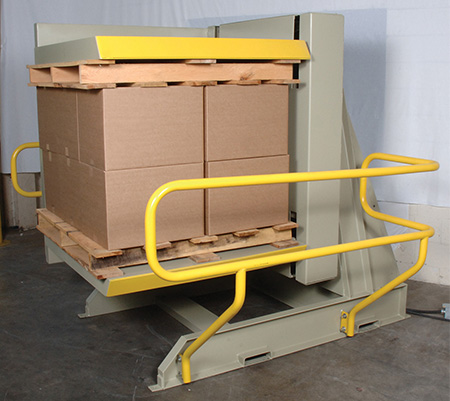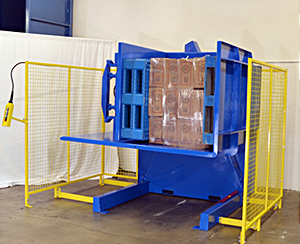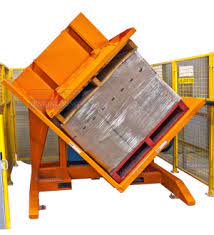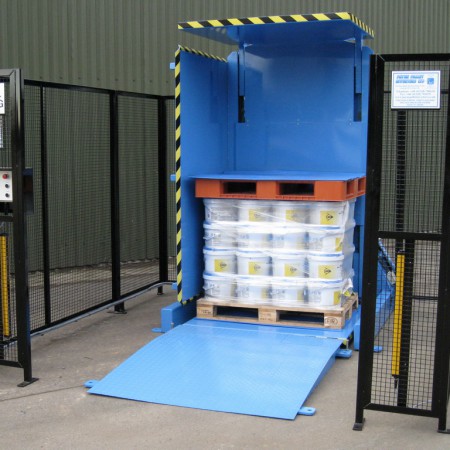Pallet Inverter Safety Tips for Europe Plants Facing Multi-Standard Adaptability Across EU Warehouses
As an engineer who has spent his entire career in the packing machine industry, I've seen firsthand how a single piece of equipment can make or break an operation. You might be managing multiple facilities across Europe, each with its own set of rules, pallet sizes, and workflow. You know a pallet inverter could streamline your process, but you worry about the complexity. Will a machine that's compliant in Germany pass inspection in Spain? The fear is real. A wrong choice can lead to costly downtime, safety incidents, and a logistical nightmare that ripples through your entire supply chain. This isn't just about buying a machine; it's about making a strategic investment that works everywhere. I’ve navigated these challenges myself and for my clients, and I want to share what I've learned to ensure your next pallet inverter is an asset, not a liability.
The key to ensuring pallet inverter safety and adaptability in Europe is a three-part strategy. First, you must verify genuine CE marking backed by a full technical file compliant with the Machinery Directive 2006/42/EC. Second, conduct a specific risk assessment for each warehouse to account for local layouts and traffic. Third, choose a machine designed for multi-standard pallet handling, capable of switching between EUR-pallets, CHEP, and other regional types without compromising safety or efficiency.

Getting the right machine with the right certifications is a critical first step. But true success comes from how that machine integrates into your specific environment and how your team uses it. The regulations provide the framework, but operational excellence is built on practical application. Let's break down how to approach this, moving from broad compliance to the specific details that ensure safety and productivity on your warehouse floor.
How can you ensure your pallet inverter meets diverse EU safety standards?
You've identified a potential supplier for a new pallet inverter. The brochure looks great, and it has a CE mark. But you know that a warehouse manager in Poland might have different expectations or local enforcement priorities than one in France. You're concerned that a machine cleared for one country might cause unexpected issues in another, leading to fines or, worse, a complete work stoppage during a critical audit. I've seen this happen. A client once bought a machine that was technically compliant but its guarding was impractical for their specific workflow, causing constant operational friction. The solution is to look beyond the CE sticker and understand the foundational standards that guarantee safety across the entire EU.
To ensure your pallet inverter meets diverse EU safety standards, you must look beyond the CE mark itself. You need to request and review the manufacturer's Declaration of Conformity (DoC). This document confirms the machine complies with the Machinery Directive 2006/42/EC and lists the specific harmonized standards, such as EN ISO 12100 for risk assessment and EN 60204-1 for electrical safety, that were used in its design and construction.

A deep dive into these standards is where you separate a truly reliable supplier from the rest. It shows they have done their homework and built a machine that is safe by design, not just by paperwork. This knowledge empowers you to ask the right questions and verify that the equipment is fundamentally sound, no matter which European warehouse you install it in. It’s about building a foundation of trust in the equipment itself.
Deconstructing the CE Mark and Declaration of Conformity
Many people see the CE mark as a certification from a third-party body. In reality, for most machinery like pallet inverters, it's a self-declaration by the manufacturer. They are stating that their product meets all relevant EU directives. This is why you can't just trust the sticker. You must ask for the supporting documentation.
The most important document is the Declaration of Conformity (DoC). This is a legally binding paper where the manufacturer takes responsibility. It should clearly state:
- The manufacturer's name and address.
- A description of the machine (model, serial number).
- A list of all directives it complies with (Machinery Directive 2006/42/EC is the main one).
- A list of the specific harmonized standards applied.
If a supplier is hesitant to provide this, it's a major red flag. A confident, professional manufacturer will have this ready. I remember a time I was vetting a new supplier. I asked for the DoC and the technical file. They sent it over within the hour. That small action told me a lot about their professionalism and confidence in their product.
Key Harmonized Standards for Pallet Inverters
The DoC will list several standards. You don't need to be an expert in all of them, but you should recognize the most critical ones for a pallet inverter. These standards provide a clear framework for safety.
| Standard | What It Covers | Why It Matters for Your Pallet Inverter |
|---|---|---|
| EN ISO 12100 | General principles for risk assessment and reduction. | This is the foundation. It shows the manufacturer systematically identified and mitigated potential hazards. |
| EN ISO 13849-1 | Safety-related parts of control systems. | This ensures that safety functions like emergency stops and light curtains are reliable and won't fail. |
| EN 60204-1 | Electrical safety of machinery. | This standard protects your staff from electrical shocks and your facility from fire hazards. |
| EN ISO 13857 | Safety distances to prevent hazard zones being reached. | This dictates the design of safety fences and the placement of light curtains to keep operators safe. |
The True Meaning of "Multi-Standard Adaptability"
Adaptability isn't just about handling different pallet sizes. It's about a design that respects the varying operational practices and safety interpretations across Europe. For example, some national work authorities may have stricter interpretations of guarding requirements. A good pallet inverter should offer flexible safety options, like modular fencing or configurable light curtain zones, that can be adjusted to meet specific site requirements without needing a complete redesign. This is where a supplier becomes a partner. They should ask you about your different warehouse layouts and help you configure the machine's safety features for each location, ensuring compliance and smooth operation everywhere.
What are the critical risk assessment steps for pallet inverter installation in a European warehouse?
The new pallet inverter has arrived at your warehouse. It's CE marked, the paperwork is in order, and your team is ready to get it running. The temptation is to find a space, plug it in, and start working. But this is one of the most dangerous moments. The machine itself might be safe in isolation, but its interaction with your environment creates a whole new set of risks. How will forklift traffic flow around it? Is the emergency stop easily accessible from where the operator will stand? I once visited a plant where a pallet inverter was installed in a busy aisle. A near-miss occurred when a forklift driver swerved to avoid a pedestrian and almost hit the machine operator. The accident wasn't caused by the machine failing, but by a failure to assess its place in the wider system.
The critical risk assessment steps for installing a pallet inverter involve three phases. First, a pre-installation analysis of the site layout, traffic flow, and floor integrity. Second, a hazard identification process covering all operational phases, from loading to maintenance. Third, the implementation and verification of control measures, like physical guarding and Lock-Out/Tag-Out (LOTO) procedures, before the machine goes into full service.

A manufacturer's risk assessment covers the machine itself. Your responsibility is the installed machine. This site-specific assessment is not just a bureaucratic step; it's a practical blueprint for safety. It transforms a standalone piece of equipment into a safely integrated part of your production line, protecting your people and ensuring smooth, predictable operations.
Phase 1: Pre-Installation Site Analysis
Before the first bolt is tightened, you need to map out the environment. This isn't just about finding an empty space. You must consider:
- Traffic Flow: Where do forklifts, pallet jacks, and people move? The inverter should be placed to minimize interaction and crossing paths. Ideally, it should be in a dedicated, clearly marked area.
- Floor Loading: A pallet inverter plus a full, heavy load exerts significant point pressure on the floor. You must confirm that your concrete slab can handle the static and dynamic loads without cracking.
- Utilities: Where are the power and compressed air hookups? Running cables or hoses across walkways creates trip hazards. Plan the installation so that all utilities are cleanly and safely routed.
- Lighting and Space: The area must be well-lit. There must also be sufficient space around the machine for operators to work without being cramped and for maintenance staff to access all service points safely.
Phase 2: Hazard Identification for All Operational Phases
Once you've chosen the spot, think through every step of how the machine will be used. I recommend creating a simple table to be thorough.
| Hazard Type | Example during Pallet Inversion | Mitigation Strategy |
|---|---|---|
| Crushing | Operator's hand or foot getting caught in the clamping mechanism. | Use fixed guarding or light curtains to create an exclusion zone. Implement two-hand controls for initiating the cycle. |
| Shearing | Moving parts of the rotating frame passing a fixed part of the chassis. | Ensure all moving parts are fully enclosed within the machine's frame or behind secure fencing. |
| Impact | A forklift hitting the machine while delivering a pallet. | Install floor-mounted steel bollards or guard rails around the corners of the machine. Paint clear safety lines on the floor. |
| Ergonomic | Operator straining their back by manually handling pallets. | Position the inverter to be loaded/unloaded at an ergonomic height. Integrate with roller conveyors to slide pallets. |
| Electrical | Maintenance staff getting a shock from stored energy. | Enforce a strict Lock-Out/Tag-Out (LOTO) procedure for all maintenance, repair, and cleaning tasks. |
Phase 3: Implementing and Verifying Controls
This is where your assessment turns into action. You install the physical guards, paint the lines, and finalize the LOTO procedures. But you're not done yet. Before handing the machine over to production, you must verify that every safety measure works as intended.
- Test every E-stop button.
- Test the light curtains. Walk through them during a cycle (at a safe test speed) to ensure the machine stops immediately.
- Run several test loads. Watch the full cycle. Observe how the operator interacts with the controls. Ask them for feedback. Do they feel safe? Is the process logical?
This verification step is non-negotiable. It’s your final confirmation that your plan works in the real world.
Why is operator training the most overlooked aspect of pallet inverter safety?
You have done everything by the book. You selected a fully compliant pallet inverter. You conducted a detailed risk assessment and installed robust safety guarding. You feel confident that your facility is safe. But a few months down the line, you notice a safety gate has been propped open with a wooden wedge. An operator did it to save a few seconds on each cycle. In that moment, your multi-thousand-euro investment in safety technology was defeated by a small piece of wood. I've seen this exact scenario play out. The best engineered systems in the world are vulnerable to human behavior. We often focus so much on the hardware that we forget the person who uses it every single day.
Operator training is the most overlooked aspect of pallet inverter safety because it's often viewed as a one-time event and a cost, rather than a continuous process and a critical investment. Effective, ongoing training is what bridges the gap between a machine's designed safety features and its actual safe use on the warehouse floor. It empowers operators to not only follow procedures but to understand the risks, prevent misuse, and identify potential problems before they lead to accidents or downtime.

Investing in training provides the highest return on investment for safety. A well-trained operator doesn't just run a machine; they take ownership of it. They become your first line of defense, transforming your safety program from a set of rules into a shared culture of responsibility.
Moving Beyond a Simple Demonstration
Too often, "training" consists of a technician showing an operator which button starts the cycle and which one is the emergency stop. This is not training; it's a demonstration. Real training goes much deeper and must cover three key areas:
- The "Why": Don't just tell operators what to do. Explain why the safety features are there. For example: "This light curtain stops the machine instantly because the clamping mechanism has enough force to cause a serious crushing injury. It's here to protect you." When people understand the potential consequences, they are far more likely to respect the safety system.
- The "How": This covers the standard operating procedures. How to correctly load a pallet to ensure it's centered. How to use the two-hand controls properly. The correct sequence for starting and stopping a cycle. It also includes what to do when something goes wrong, like the procedure for clearing a jam safely.
- The "What If": This is proactive training. What does a specific error code on the HMI screen mean? What should an operator do if they hear an unusual noise, like a grinding or squealing sound? Who should they report it to? This type of training turns operators into active participants in predictive maintenance, helping you prevent breakdowns and support your goal of high equipment uptime.
Building a Culture of Safety, Not Just a List of Rules
Training should not be a one-time event upon installation. It needs to be a continuous process.
- Regular Refreshers: Schedule short, practical refresher sessions every six months or annually.
- Involve Operators in Improvements: Operators use the machine all day. They often have the best ideas for small improvements. I remember a case where an operator suggested adding a small mirror to a corner of the machine. This simple, low-cost idea eliminated a blind spot and made it much easier to align pallets. We implemented it immediately. By listening to him, we not only made the machine safer, but we showed him and his colleagues that their input was valued. This builds a powerful sense of ownership.
- Train Your Maintenance Team: Ensure your maintenance staff is fully trained on the LOTO procedures, the electrical system, and the hydraulic/pneumatic components. Their safety is just as important.
A training program isn't an expense. It's the essential software that runs on your safety hardware.
How do modern pallet inverters improve both safety and efficiency in a high-turnover warehouse?
As a plant owner, you are constantly balancing two critical demands: you must ensure the safety of your people, and you must hit your production and cost targets. Often, these two goals seem to be in conflict. A new safety procedure might add seconds to a cycle time, and that time adds up. You feel caught between investing in safety measures that feel like they slow things down and pushing for the efficiency needed to stay profitable. It can feel like you have to choose one over the other. But from my experience building these machines, I can tell you that this is a false choice.
Modern pallet inverters are engineered to improve safety and efficiency at the same time. They achieve this by integrating safety features directly into the machine's core functions. For example, automated clamping systems, integrated conveyors, and intelligent PLC controls not only make the process safer by reducing manual handling and operator error, but they also optimize cycle times, prevent product damage, and provide diagnostic data that reduces unplanned downtime.

The right pallet inverter is not a cost center. It is a dual-purpose asset that directly addresses your core goals of higher uptime and lower operational costs. Let's look at the specific features where safety and efficiency work together.
The Powerful Synergy Between Safety Features and Uptime
In a well-designed machine, the features that protect your workers also make your operation more robust and efficient. The design philosophy shifts from adding safety as an afterthought to making the process inherently safe and fast. This synergy is a key factor in achieving goals like 95% equipment uptime and reduced operational costs.
| Safety Feature | How It Directly Boosts Efficiency and Reduces Costs |
|---|---|
| Area Scanners / Light Curtains | Instead of physical gates that must be opened and closed, these create an invisible barrier. This allows for faster loading with a pallet jack, reducing cycle time and eliminating the mechanical wear of a gate. |
| Automated Clamping Pressure | The machine automatically detects the load height and applies the precise pressure needed. This prevents product damage from over-clamping, which reduces waste, rework, and customer complaints. |
| PLC with Advanced Diagnostics | The same system that monitors safety sensors can also track cycle counts, motor performance, and hydraulic pressure. It provides early warnings for maintenance (e.g., "Filter needs replacement in 10 hours"), allowing you to schedule downtime and avoid a sudden breakdown. |
| Integrated Conveyor Systems | Automating the entry and exit of pallets eliminates forklift interaction at the machine. This is a huge safety win, but it also creates a smooth, continuous flow that paces your entire line and drastically cuts down on handling time. |
The Financial Return on Adaptability and Ease of Use
In a modern European warehouse, you might be handling products on EUR-pallets for one customer and plastic CHEP pallets for another. "Multi-standard adaptability" is not a luxury; it's an economic necessity.
- Reduced Changeover Time: A modern pallet inverter should be able to adjust for different pallet sizes and types with a simple selection on an HMI screen, or even automatically. Older designs might require manual adjustments with tools, leading to significant downtime between batches. A machine that can switch in seconds saves hours of lost production time each week.
- Ergonomics and Usability: A machine that is simple and intuitive to operate reduces the chance of errors that can damage products or the machine itself. Features like a clear touchscreen interface, logical button layouts, and easy access for cleaning all contribute to a smoother, faster, and less error-prone operation.
When you invest in a modern pallet inverter, you are not just buying a piece of safety equipment. You are investing in a more streamlined, predictable, and profitable process.
Conclusion
A safe pallet inverter is not an expense; it's a strategic asset for any European plant. It ensures compliance, protects your people, and boosts your operational efficiency and adaptability.




